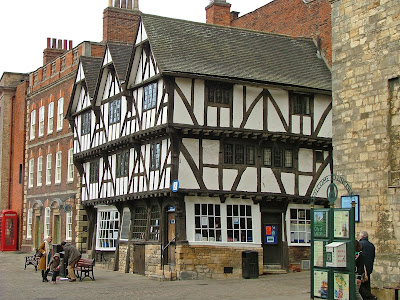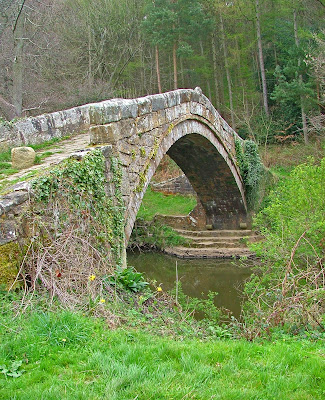LEIGH-PEMBERTON HOUSE, castle square.
This large timber framed merchant`s house situated in castle square, Lincoln, dates from around 1543. It is thought to have been a pub, possibly the Ironmongers Arms in 1666. From 1899 - 1979 it was a bank branch and it was The National Provincial Bank who extensively restored the building in 1929, later it became The National Westminster Bank following national provincial`s merger with the Westminster bank in 1968. It is now a Tourist Information Office.
JEWS HOUSE, steep hill.
Jews house dates from 1158 and is a fine example of Norman Domestic Architecture with a rich ornamental doorway and chimney. It is reputed to be the oldest domestic building in Britain. Originally it had three segmented arches for shop fronts since replaced by modern insertions. In the middle ages Lincoln had a flourishing Jewish community with money lenders, traders and merchants. The people within this community were amongst the richest and most influential citizens of Lincoln and the building reflects the affluence of the Jewish communities traders of the time. This is possibly one of the reasons the Jews were expelled from Lincoln in 1290. It was once the residence of Bellaset of Wallingford who was executed for forgery in 1290.
JEWS COURT, steep hill.
Jews court essentially dates back to the 17th and 18th centuries. Some traditions hold it to be a 12th century synagogue, with a niche in the east wall considered to be the ark, documentary sources confirm that there was a synagogue against the Jews house until the expulsion of the Jews in 1290, but this may have actually been located to the rear. From 1800 the property was divided into four tenements and only just escaped demolition in late 1920`s slum clearance.
THE CROOKED HOUSE, michaelgate
This close studded timber framed building under built in brick dates from 1500. The south gable rests on a stone dwarf wall. It was renovated and refenestrated in 1935, exposing the timber beams and brickwork, it is also sometimes known as the bendy house.
ST MARY MAGDALENE CHURCH.
The church of St Mary Magdalene stands at the crossroads at the heart of the cathedral quarter, it is the parish church for the Bail and Steep Hill and for the Cathedral. The original Saxon church was knocked down to build the cathedral. The parishioners were later given the present church site on the north side of the exchequer. The exchequer was a medieval shopping centre and this began the long connection of St Mary Magdalene`s with the retail activity in the bailgate area. Records show that there were two shop units in the crypt below the church accessed from a doorway in the wall facing the exchequer. The outline of the blocked south doorway can still be seen in the stonework. Today St Mary Magdalene`s is home to a lively, all age congregation which actively engages with the community on bailgate and steep hill.
THE HARLEQUIN, steep hill.
The Harlequin, only a stones throw away from Lincoln`s first theatre which opened in Drury Lane in 1744, was a regular drinking haunt of the theatre folk. Although looking like a typical late 15th century timber-framed building some of the interior dates back to the 12th century. Although still sporting the Harlequin sign the building is now an antiquarian and second-hand bookshop.
To be continued.











